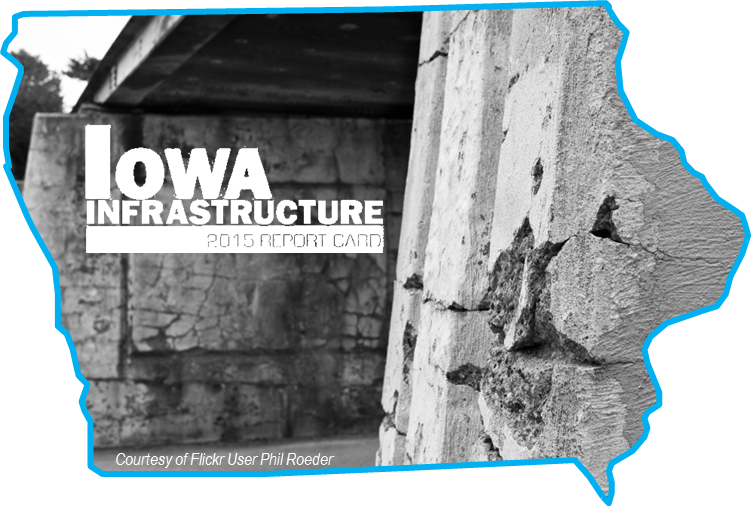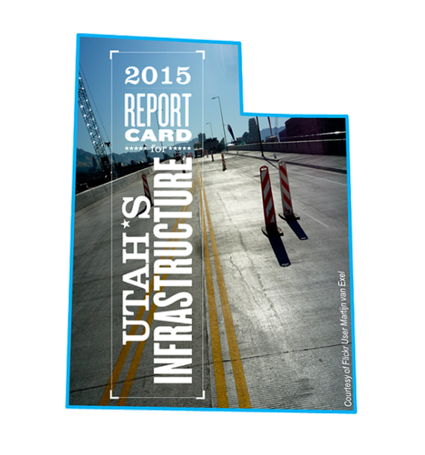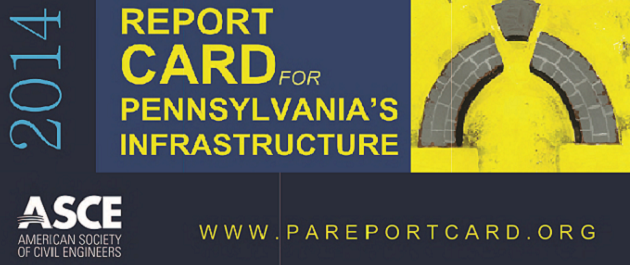2015 Infrastructure Year in Review
January 4th, 2016 | By: America's Infrastructure Report Card
App Makes Contacting Legislators a Breeze
 In 2015, both Utah and Iowa rapidly passed transportation legislation reforms on the heels of the release of ASCE’s State Infrastructure Report Cards. In fact, ASCE has released a recent Report Card in 12 of the 15 states that have taken recent significant action on infrastructure. These states include: GA, ID, IA, KY, MD, NE, NH, NC, PA, SD, UT, VT, VA, WA, and WY.
Sharing the Report Card with Business and Industry Leaders
The Report Card for America’s Infrastructure continues to draw interest from business and industry groups nationwide. Almost 50 Report Card presentations have been given by ASCE leaders to groups ranging from the Dallas Regional Chamber of Commerce to the US/Canada P3 Forum to the Association of Actuaries. Request a presentation to your group by emailing reportcard@asce.org.
In 2015, both Utah and Iowa rapidly passed transportation legislation reforms on the heels of the release of ASCE’s State Infrastructure Report Cards. In fact, ASCE has released a recent Report Card in 12 of the 15 states that have taken recent significant action on infrastructure. These states include: GA, ID, IA, KY, MD, NE, NH, NC, PA, SD, UT, VT, VA, WA, and WY.
Sharing the Report Card with Business and Industry Leaders
The Report Card for America’s Infrastructure continues to draw interest from business and industry groups nationwide. Almost 50 Report Card presentations have been given by ASCE leaders to groups ranging from the Dallas Regional Chamber of Commerce to the US/Canada P3 Forum to the Association of Actuaries. Request a presentation to your group by emailing reportcard@asce.org.
 Highlighting #GameChangers and Solutions
In July, ASCE released Infrastructure #GameChangers report to highlight the innovative ways communities across the country are modernizing infrastructure. The report highlights trends in energy, freight, transportation and water infrastructure that are changing the way we design, plan, and build projects of the future.
Read the full ASCE 2015 Year in Review here.
Highlighting #GameChangers and Solutions
In July, ASCE released Infrastructure #GameChangers report to highlight the innovative ways communities across the country are modernizing infrastructure. The report highlights trends in energy, freight, transportation and water infrastructure that are changing the way we design, plan, and build projects of the future.
Read the full ASCE 2015 Year in Review here.
For Michigan Roads: 8 is Great!
November 10th, 2015 | By: Maria Matthews
Last week, Michigan’s legislature passed into law a 7.3 cent per gallon fuel tax increase becoming the 8th state in 2016 to increase investment in its transportation infrastructure. Today Governor Rick Snyder (R) signed this bill into law outside of the Michigan Infrastructure and Transportation Association headquarters. Today’s bill signing is at least one year in the making! Last fall, the legislature worked diligently to put together a package to increase road funding in advance of a projected harsh winter. Working long hours up to the last day of the 2014 session a committee of key legislators met with the Governor’s office to no avail. These negotiations were only able to yield a failed ballot measure in May of this year. Nonetheless, the two chambers went back to work while Governor Snyder continued to tour the state championing leading us to this long awaited moment in time. Michigan’s surface transportation currently has a backlog of needs due to decades of under investment. 22% of the state’s roads are in poor condition and 12% of the state’s bridges are structurally deficient. The state also made national news earlier this year because of its public transit system’s lack of service in Metro Detroit. To address these needs, the new law will raise the gas tax to 26.3 cents per gallon starting January 1, 2017. The first increase the state has seen since 1997. The additional tax revenue is expected to generate nearly $600 million in new revenue. Additional funds will come from the 20% increase in vehicle registration, which themselves have not increased in 30 years, and additional fees for hybrid and electric vehicles. Additional road funding will come from a shift in funds from the general fund beginning with a $150 million transfer in the 2018-19 budget reaching a maximum of $600 million by 2021. When fully implemented it is expected the package will generate $1.2 billion. The tax increase and higher fees are expected to be offset by a yearly reduction in personal income taxes beginning in 2023 and property tax credits. While the net effect of today’s bill signing is still a few years in the making, Michigan is off to a good start. Increased investment means safer roads and bridges for commuters and the potential for economic growth as businesses can more readily get their goods to market. We applaud Michigan’s legislative body and the Governor have who have helped chart a course toward better and safer future.Holiday Travel Will Further Stress Nation’s Ailing Highways
July 2nd, 2015 | By: Olivia Wolfertz
With Independence Day around the corner, now is a good time to reflect upon the freedoms we have enjoyed for the past 239 years. To this day, our national interstate highway system represents the freedom of mobility that we enjoy as Americans. This holiday weekend, AAA is predicting that nearly 42 million Americans will travel at least 50 miles from home on the nation’s roads and highways. Given the dire condition and investment needs of our surface transportation, Congress must remember that ultimately they are responsible for maintaining and modernizing our transportation network. Despite Congress’ constitutional responsibility to fund surface transportation, our lack of federal road, bridge and transit funding means has led many states to step up transportation funding themselves. Six states have increased their gas tax starting July 1, including Idaho, Georgia, Maryland, Rhode Island, Nebraska and Vermont. Earlier this week, Washington joined other states this year in passing a transportation bill that includes a gas tax increase of 12 cents per gallon. This is reflective of the trend noted recently in Huffington Post about the many states that have enacted transportation funding this year, while another 16 are in the process of doing so. These actions will “generate billions of additional dollars” for local transit and highway projects. As motorists hit the roads this weekend, let’s hope that the traffic headaches they will certainly face will motivate Congress to come up with a funding solution to #FixTheTrustFund.Be a Part of Infrastructure Week
April 29th, 2015 | By: Infrastructure Report Card
 The national week dedicated to highlighting the critical importance of investing in and modernizing America’s infrastructure systems, and the essential role infrastructure plays in our economy is May 11-15. The third-annual Infrastructure Week includes more than 30 events around the country from Alaska to Louisiana to New York.
A few of the events include:
The national week dedicated to highlighting the critical importance of investing in and modernizing America’s infrastructure systems, and the essential role infrastructure plays in our economy is May 11-15. The third-annual Infrastructure Week includes more than 30 events around the country from Alaska to Louisiana to New York.
A few of the events include:
- MONDAY in Washington, D.C. – Infrastructure Week Launch: Breaking through to the Future
- TUESDAY in Cleveland, OH – Follow the Flow: Celebrating Clean Water Investments in the Cleveland Metro
- WEDNESDAY in Pittsburgh, PA – Pittsburgh on the Move and Infrastructure Advocacy Day in Washington, D.C.
- THURSDAY in New Orleans, LA – Infrastructure Delivers More Than You Think with Tour of Port NOLA
- FRIDAY in Washington, D.C. – Building Resilience through New Financing Vehicles
Tags: infrastructure, planes, ports, report card, roads, states, trains
No Comments »
Dams in 26 States Are Getting Some TLC
December 30th, 2014 | By: Infrastructure Report Card
While the average person might think it’s just about farms, the Farm Bill funding for dams was perhaps one of the most unsung wins for infrastructure in 2014. The 2014 Farm Bill that Congress passed in the summer provided USDA with $262 million to distribute to states for rehabilitating dams. The funding provided rehabilitation assistance for 150 dams in 26 states. This increased the typical annual investment in rehabilitation 20 times over! Dam infrastructure’s role in flood management, water supply, and agricultural productivity is critical to the economy. Here’s a quick breakdown of the Watershed Rehabilitation assistance by state:| Project Name | Assistance Provided |
| Arizona | $98,137,300 |
| Texas | $33,842,975 |
| Oklahoma | $26,420,000 |
| West Virginia | $14,200,099 |
| Utah | $12,655,000 |
| Pennsylvania | $11,380,500 |
| Massachusetts | $8,976,000 |
| Nebraska | $7,515,236 |
| Virginia | $7,285,000 |
| Mississippi | $5,675,000 |
| Colorado | $2,940,000 |
| New York | $2,900,000 |
| Tennessee | $2,300,000 |
| Kansas | $1,751,000 |
| Oregon | $1,374,000 |
| Kentucky | $1,163,000 |
| Ohio | $708,000 |
| New Mexico | $600,000 |
| Wyoming | $543,103 |
| Connecticut | $450,000 |
| Arkansas | $445,500 |
| North Dakota | $294,000 |
| Nevada | $280,000 |
| Idaho | $249,000 |
| Georgia | $225,000 |
| New Hampshire | $50,000 |
Tags: congress, dams, Farm Bill, safety, states
No Comments »
Pennsylvania Earns 7 Poor D Grades in New Report Card
June 25th, 2014 | By: Infrastructure Report Card
Today, civil engineers from across Pennsylvania released a new Report Card for Pennsylvania’s Infrastructure giving 16 grades for the state’s infrastructure. Here’s how Pennsylvania’s infrastructure ranks from worst grades to best: Roads D- Wastewater D- Drinking Water D Transit D Bridges D+ Inland Waterways D+ Stormwater D+ Dams C- Levees C- Schools C- Energy C Solid Waste C+ Ports C+ Hazardous Waste B- Parks and Rec B- Freight Rail B The Report Card found that Pennsylvania faces immense challenges to maintaining and modernizing infrastructure throughout the state:- Pennsylvania has the highest percentage of structurally deficient bridges in the country. Of the Commonwealth’s more than 22,000 bridges, nearly one in four are considered structurally deficient.
- Pennsylvania has the most combined sewer overflows (CSOs) of any state.
- The Commonwealth must invest $28 billion over the next 20 years to repair existing wastewater systems, meet clean water standards and build or expand existing systems to meet increasing demands
- Pennsylvania’s 1.3 traffic fatalities per 100 million miles of travel is significantly higher than the national average (1.1).
- KEEP UP THE MOMENTUM FOR BETTER INFRASTRUCTURE: In 2013, Pennsylvania’s officials showed leadership by passing a transportation package that will start putting the roads, bridges, and transit systems back into working order.
- AFFIRM PUBLIC SAFETY AS GOVERNMENT’S #1 JOB:Whether it’s repairs to bridges, ensuring safe drinking water, or keeping up on dam safety inspections, public safety must always be the first priority as leaders budget and plan for the future. Ensuring infrastructure is resilient and online 99.9% of the time will keep communities safe and the economy thriving.
- STOP WASTING MONEY BY WAITING: Of the 7 infrastructure categories with D grades, all of these deal with transportation and water systems, and much of the repairs and long-term funding are being short-changed. Waiting will only lead to larger issues that will disrupt lives and cost even more when the bill comes due. Pennsylvania must look at the full cost of decisions and then put savings to use.
Tags: Act-89, grades, momentum, Pennsylvania, report card, states, transportation, water
No Comments »



 */ ?>
*/ ?>












